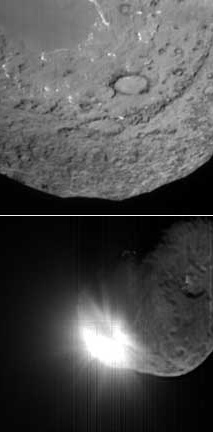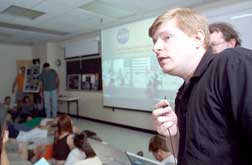Deep Impact wows overflow audience at Cornell's Space Sciences Building
By Lauren Gold

They came -- scientists, students, families, curious teenagers and interested locals -- with the hope that Monday's 1:52 a.m. Deep Impact comet collision would be something worth staying up for.
And it was.
"Spectacular," said Cornell University assistant professor of astronomy Jean-Luc Margot when it was over.
"Cool," agreed Boynton Middle School student Chenga Drury.
The encounter, 552 million kilometers (83 million miles) from Earth, pitted a 370-kilogram (820-pound) camera-equipped copper probe against the Manhattan-sized comet Tempel 1, with a flyby spacecraft to observe the crash. The mission, part of NASA's Discovery Program, was designed to give scientists a first-time glimpse into the nucleus of a comet.
Organizers hoped 50 people might show up at Cornell's Space Sciences Building in the early hours of Monday morning to watch the impact. By 1 a.m., building manager Bill Hoffman estimated the crowd at close to 400. "We never thought we would have this many," he said. Staff members scrambled to open an overflow viewing room on the building's third floor -- but within minutes it was as packed as the first-floor seminar room. "Unbelievable," said Hoffman. "We never expected a turnout like this."
They came, perhaps in part, for the uncertainty of it all. As Tempel 1 bore down on what Jet Propulsion Laboratory (JPL) scientist Don Yeomans called "our intrepid little spacecraft," no one could predict the outcome with authority.
Some, like physics graduate student Bruno Rousseau, kept their expectations in check. "I think it's just going to go bloop -- and nothing's going to happen," he mused. Others, like Brooktondale resident Steve Mulchahey, were a tad concerned. "I'm fearful that it's going to break apart and change its trajectory," he said.
Peter Thomas, senior research associate in Cornell's astronomy department and Deep Impact team member, assured the audience that the comet's path would not be affected by the impact. But beyond that, he said, "the betting pools go over a wide range of what could happen."

Thomas, who led the event at Space Sciences, watched the NASA TV broadcast between informal presentations and question-and-answer sessions. Margot and physics graduate student John Karcz also spoke.
Near the front of the room, Zachary Holbrook, 8, slept with his head on his father Jay's lap.
At T minus 20 seconds, the room quieted. Jay nudged Zachary, who sat up and gazed, a bit glassy-eyed, at the projection screen.
The first pictures, taken by the doomed probe seconds before it was demolished, were clear and detailed, showing bumps and distinct circular patterns on the comet's surface. Then, the flyby spacecraft took over, sending back images of the brilliantly lit comet with a giant poof of debris shooting out at the impact site.
Between comet shots, the broadcast showed giddy team members cheering at the mission control center in NASA's JPL. The Space Sciences crowd echoed the cheers.
Astronomers are interested in comets because they've changed very little since the formation of the universe. With information from Deep Impact's data collectors -- the flyby spacecraft's high-resolution instrument (which includes a camera and infrared spectrometer) and medium-resolution instrument, as well as the impactor's camera -- scientists hope to learn more about the comet's composition and density.
In the coming weeks, Thomas and astronomy department chair Joe Veverka will analyze the images and use them to construct three-dimensional maps of Tempel 1. Veverka watched the impact from JPL.
Michael A'Hearn, professor of astronomy at the University of Maryland, is principal investigator for the mission. The University of Maryland is responsible for mission science, and project management is handled by JPL. The spacecraft was built for NASA by Ball Aerospace & Technologies Corp. in Boulder, Colo.
As the action wound down around 3 a.m., Molly Lebowitz, an undergraduate in the College of Engineering, searched for friends and prepared to leave.
A successful night, she noted. Satisfying.
"I was thinking it was going to be kind of anticlimactic," she said. "But it was good. Chalk one up for the humans."
Media Contact
Get Cornell news delivered right to your inbox.
Subscribe